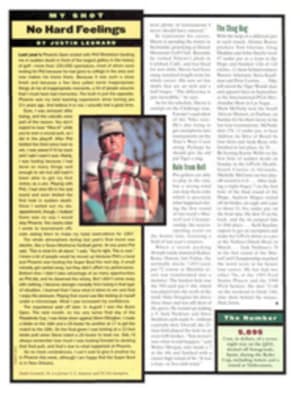
GOING NOWHERE FAST THE URGE TO ERG DRIVES INDOOR ROWERS AT THE ANNUAL C.R.A.S.H.-B. SPRINTS
"Ernie! Ernie! Ernie!" the crowd chanted, the sound
reverberating through the cavernous indoor track facility at
Harvard University, where the 1996 World Indoor Rowing
Championships were taking place. While sliding back and forth on
an exercise device known as an ergometer--a stationary rowing
machine that looks more like a giant mechanical insect than a
crew shell--Ernie pulled powerfully on the handle attached to a
chain that in turn wound around a flywheel.
A "coxswain" sat in a chair next to each of the competitors,
shouting encouragement, giving time splits or counting strokes
out loud. Ernie's coxswain did all of these things, but every 30
seconds or so she also spritzed water into the exhausted rower's
mouth. On small TV-sized monitors, numbers indicating time and
distance traveled flashed for each rower's benefit. Ernie had
only a few meters left in the 2,000-meter race. The crowd's
chanting seemed to grow louder with each stroke until, suddenly,
a single voice broke through the din, exhorting Ernie loudly,
"Come on, Mom! Only 30 to go!"
Ernie, you see, was 86-year-old Ernestine Bayer, a white-haired
lady who wore gold clip-on earrings, a tasteful plum-colored
shade of lipstick and an intimidating black-and-blue Lycra
rower's unitard. Bayer, who lives in Stratham, N.H., and has
been rowing on the water ever since founding the Philadelphia
Girls' Rowing Club in 1938, was being cheered to a third-place
finish among the six women competing in the 60-plus age group.
Although she was rowing for more than a minute longer than any
of her competitors, Bayer's handicapped score put her ahead of
women young enough to be her children, and with a raw time of
11:14.0, she set a world indoor rowing record for women 80-89
years old.
Bayer was one of the 1,519 hammers--rowers for whom sheer force
counts more than finesse--at the Indoor Rowing championships,
also known as the C.R.A.S.H.-B. Sprints after the Charles River
All-Star Has Beens, several Boston-based former Olympic and
national team oarsmen who founded the club in 1978.
The C.R.A.S.H.-B. races began in 1982 with 85 rowers eager to
enliven the dreary months of winter training. Over the next
decade and a half, the rowers' casual training-room challenges
burgeoned into a bona fide, if slightly tongue-in-cheek,
international athletic event. This year's championships are
scheduled for Feb. 16 at the Reggie Lewis Athletic Center of
Roxbury Community College in Boston. Participants range from
national outdoor rowing champions and Olympic hopefuls to high
school students. But just so no one loses perspective, the media
guide soberly states in its Provisional Rules of Competition,
"All decisions of the Regatta Committee are secret, arbitrary,
and final."
Paul Hendershott, one of the athletes at last year's single-day
event, on Feb. 25, was one example of how popular indoor rowing
has become. Hendershott, 52, the world indoor record holder in
the 50-59 age bracket, had never rowed on water. He had,
however, "erged" an astronomical 3.5 million meters a year in
1993 and '94. In '94 he was the first 50-year-old to break eight
minutes for 2,500 meters indoors, with a time of 7:56.8. He
brought that time down by four seconds when he won his third
world indoor title in '95. And in the 1996 Sprints--now 2,000
meters, the international racing standard--he easily won the
veteran men's race, and another world record, with a scratch
time of 6:19.4.
As Ernie crossed the imaginary 2,000-meter finish line, the
crowd was cheering so loud that she could not hear her daughter
Tina shouting to her that she had made it. Not until Ernie
finally opened her eyes several strokes later and saw the
monitor flashing did she ease up, which prompted one awed
spectator, deep in the crowd, to say to no one in particular,
"What a hammer."
COLOR PHOTO: BRIAN HILL Hundreds of racers, some of whom have never rowed on water, pull hard for imaginary finish lines. [Time-lapsed photograph of people on rowing machines]

